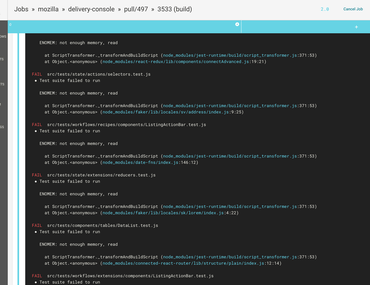tl;dr; Use --runInBand when running jest in CI and use --maxWorkers=3 on your laptop.
We have a test suite that covers 236 tests across 68 suites and runs mainly a bunch of enzyme rendering of React component but also some plain old JavaScript function tests. We hit a problem where tests utterly failed in CircleCI due to running out of memory. Several individual tests, before it gave up or failed, reported to take up to 45 seconds.
Turns out, jest tried to use 36 workers because the Docker OS it was running was reporting 36 CPUs.
> circleci@9e4c489cf76b:~/repo$ node
> var os = require('os')
undefined
> os.cpus().length
36
After forcibly setting --maxWorkers=2 to the jest command, the tests passed and it took 20 seconds. Yay!
But that got me thinking, what is the ideal number of workers when I'm running the suite here on my laptop? To find out, I wrote a Python script that would wrap the call CI=true yarn run test --maxWorkers=%(WORKERS) repeatedly and report which number is ideal for my laptop.
After leaving it running for a while it spits out this result:
SORTED BY BEST TIME: 3 8.47s 4 8.59s 6 9.12s 5 9.18s 2 9.51s 7 10.14s 8 10.59s 1 13.80s
The conclusion is vague. There is some benefit to using some small number greater than 1. If you attempt a bigger number it might backfire and take longer than necessary and if you do do that your laptop is likely to crawl and cough.
Notes and conclusions
- Doing
--runInBandis the same as--maxWorkers=1apparently. - @thymikee, a core
jestcontributor suggests to use--runInBandin CI. - The times might not matter much because on your laptop you probably use
--watchwith a filter anyway. - If someone feels productive, please copy my Python script and run it inside a Docker container in CircleCI and report their findings.

Comments